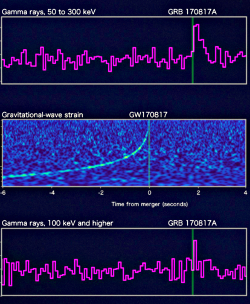 HEAPOW: Connecting Light and Gravity (2017 Oct 16)
HEAPOW: Connecting Light and Gravity (2017 Oct 16)
Massive stars (8 or more times the mass of the sun) often occur in gravitationally bound pairs in orbit around each other. Inevitably, in these pairs, one star will run out of nuclear fuel before its companion, collapsing and exploding as a supernova. In some instances the exploded star will leave behind its core as an ultradense neutron star which can be still gravitationally bound in orbit around the companion star. The companion too will eventually explode as a supernova, and it too can leave behind a neutron star. Thus the original massive binary system may form a gravitationally bound pair of neutron stars. One famous example of such a binary system is the binary pulsar, discovered in 1974. Such systems are doomed, since they lose orbital energy through the emission of gravitational waves. Gravitational waves are tiny ripples in spacetime produced by the acceleration of massive bodies, as predicted by Einstein in 1915. Amazingly, spacetime oscillations produced by merging black holes have been recently detected by the LIGO and Virgo gravitational wave detectors. But these black hole mergers are dark, producing no observable electromagnetic radiation. Merging neutron stars, on the other hand, should produce bursts of electromagnetic radiation along with bursts of gravitational radiation. Neutron star mergers are believed to be the source of incredibly powerful, but short, gamma-ray bursts like those seen by the Fermi Gamma-ray Observatory and the Swift satellite, but no neutron star merger has ever been directly seen. Until now, that is. On August 17, 2017, the LIGO and Virgo gravitational wave observatories detected a gravitational wave source that was much longer than any previously seen. Analysis of the signal showed that the oscillations produced by the event were consistent with the merger of two neutron stars, each having a mass just a bit more than the mass of our sun. Just 1.7 seconds later, the Fermi Gamma-ray Observatory saw a short gamma-ray burst, positionally consistent with the location of the gravitational wave source. The image above shows (on the left) the Fermi and LIGO observatories, and (on the right) the Gamma-ray and gravitational wave signals produced by the merger. Follow-up observations using large earth-based telescopes as well as the Hubble Space Telescope, the Chandra X-ray Observatory, and the Swift, and INTEGRAL satellites were able to actually image the source, an exploding star in a galaxy called NGC 4993, which lies about 130 million light years from earth. The connection between gravitational and electromagnetic radiation provides, for the first time, the answer to many fundamental questions. It shows, for example, that, on a cosmic scale, the speed of gravity is the same as the speed of light, and that merging neutron stars actually do produce short bursts of Gamma-rays, and that these neutron star mergers produce precious elements like gold and platinum.
NASA Missions Catch First Light from a Gravitational-Wave Event
http://asterisk.apod.com/viewtopic.php?t=37665
| << Previous HEAPOW | High Energy Astrophysics Picture of the Week | Next HEAPOW >> |